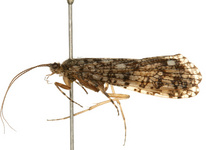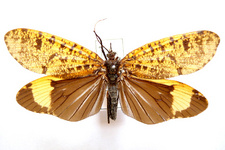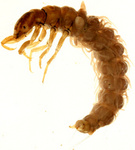Phryganeidae
Ralph W. Holzenthal, Roger J. Blahnik, Aysha Prather, and Karl Kjer


This tree diagram shows the relationships between several groups of organisms.
The root of the current tree connects the organisms featured in this tree to their containing group and the rest of the Tree of Life. The basal branching point in the tree represents the ancestor of the other groups in the tree. This ancestor diversified over time into several descendent subgroups, which are represented as internal nodes and terminal taxa to the right.

You can click on the root to travel down the Tree of Life all the way to the root of all Life, and you can click on the names of descendent subgroups to travel up the Tree of Life all the way to individual species.
For more information on ToL tree formatting, please see Interpreting the Tree or Classification. To learn more about phylogenetic trees, please visit our Phylogenetic Biology pages.
close boxIntroduction
Linnaeus’s original taxon is now a relatively small family confined to the more northern latitudes. Leach (1815) circumscribed the Linnaean genus Phryganea to the species P. grandis, and placed the genus Phryganea in the tribe Phryganides with Limnephilus. Burmeister (1839) was the first to use the name Phryganeidae, as a subfamily of Phryganeodea; Burmeister’s Phryganeidae included species currently placed in Sericostomatidae and Limnephilidae. By the late 19th century, most workers recognized a unit similar to the modern concept of Phryganeidae. Wiggins (1998) published a landmark treatise on the Phryganeidae, the only full-length book devoted to an entire family of caddisflies, which serves as the definitive reference. The family currently contains some 80 extant species in 15 genera. One genus, the monotypic Yphria Milne, from the Sierra Nevada of California and southern Oregon, is assigned to its own subfamily, Yphriinae. All other genera are in Phryganeinae. The nominotypical genus Phryganea, as currently recognized, contains only a handful of species from Asia, Europe, and North America. The largest genera (neither with more than 20 described species) are Agrypnia Curtis, found across the northern latitudes of Europe, Asia, and North America, and Eubasilissa Martynov, which is entirely Asian. Species in the latter genus include the largest extant caddisflies. Most genera contain only a handful of species: Banksiola Martynov (Nearctic), Hagenella Martynov (Holarctic), Neurocyta Navás (mountains of northern India and bordering countries), Semblis Fabricius (Palearctic), Oligotricha Rambur (Palearctic, with 1 species extending into Alaska and the Yukon). Four genera are monotypic: Agrypnetes McLachlan (Palearctic), Beothukus Wiggins (Nearctic); Fabria Milne (Nearctic); and Trichostegia Kolenati (northern and central Europe). Except in Yphria, which incorporates rock fragments into its case, phryganeid larvae construct cases of plant material, cut to size and fastened together in rings or a continuous spiral. Maybe because of their conspicuous size, adults of many phryganeid species have developed chemical and/or mechanical defense systems; many species produce an odiferous fluid from the anal opening when handled, and - uniquely within the Trichoptera - at least some species of Eubasilissa have urticating setae on the thorax and wings. Larvae are generally found among aquatic plants in ponds and marshes; some occur in slow flowing waters, a few are found in temporary pools and deep lake waters. Predation and herbivory are common larval feeding strategies in this family. (From Holzenthal et al., 2007)References
Burmeister, H. (1839) Handbuch der Entomologie, Zweiter Band, Zweite Ubtheilung. Theod. Chr. Friedr. Enslin, Berlin, xii+397–1050 pp.
Holzenthal R.W., Blahnik, R.J., Prather, A.L., and Kjer K.M. 2007. Order Trichoptera Kirby 1813 (Insecta), Caddisflies. In: Zhang, Z.-Q., and Shear, W.A. (Eds). 2007 Linneaus Tercentenary: Progress in Invertebrate Taxonomy. Zootaxa. 1668:639–698.
Leach, W.E. (1815) Entomology. Brewster's Edinburg Encyclopedia, 9, 52–172.
Wiggins, G.B. (1998) The caddisfly family Phryganeidae (Trichoptera). University of Toronto Press, Toronto, ix + 306 pp.
Title Illustrations

| Scientific Name | Agrypnia improba |
|---|---|
| Specimen Condition | Dead Specimen |
| Life Cycle Stage | Adult |
| View | Lateral |
| Source Collection | Barcode of Life Database (BOLD) |
| Scientific Name | Eubasilissa mandarina |
|---|---|
| Specimen Condition | Dead Specimen |
| Life Cycle Stage | Adult |
| View | Dorsal |
| Source Collection | Barcode of Life Database (BOLD) |
| Scientific Name | Eubasilissa maclachlani |
|---|---|
| Specimen Condition | Dead Specimen |
| Life Cycle Stage | Larva |
| View | Lateral |
| Source Collection | Barcode of Life Database (BOLD) |
About This Page
Ralph W. Holzenthal

University of Minnesota, St. Paul, Minnesota, USA
Roger J. Blahnik

University of Minnesota, St. Paul, Minnesota, USA
Aysha Prather

Centre for Biodiversity and Conservation Biology, Royal Ontario Museum, Toronto, Ontario, Canada
Karl Kjer

Rutgers University, New Brunswick, New Jersey, USA
Correspondence regarding this page should be directed to Ralph W. Holzenthal at , Roger J. Blahnik at , Aysha Prather at , and Karl Kjer at
Page copyright © 2010 Ralph W. Holzenthal, Roger J. Blahnik, Aysha Prather, and Karl Kjer
 Page: Tree of Life
Phryganeidae.
Authored by
Ralph W. Holzenthal, Roger J. Blahnik, Aysha Prather, and Karl Kjer.
The TEXT of this page is licensed under the
Creative Commons Attribution-NonCommercial-ShareAlike License - Version 3.0. Note that images and other media
featured on this page are each governed by their own license, and they may or may not be available
for reuse. Click on an image or a media link to access the media data window, which provides the
relevant licensing information. For the general terms and conditions of ToL material reuse and
redistribution, please see the Tree of Life Copyright
Policies.
Page: Tree of Life
Phryganeidae.
Authored by
Ralph W. Holzenthal, Roger J. Blahnik, Aysha Prather, and Karl Kjer.
The TEXT of this page is licensed under the
Creative Commons Attribution-NonCommercial-ShareAlike License - Version 3.0. Note that images and other media
featured on this page are each governed by their own license, and they may or may not be available
for reuse. Click on an image or a media link to access the media data window, which provides the
relevant licensing information. For the general terms and conditions of ToL material reuse and
redistribution, please see the Tree of Life Copyright
Policies.
- First online 17 July 2010
- Content changed 20 July 2010
Citing this page:
Holzenthal, Ralph W., Roger J. Blahnik, Aysha Prather, and Karl Kjer. 2010. Phryganeidae. Version 20 July 2010 (under construction). http://tolweb.org/Phryganeidae/14601/2010.07.20 in The Tree of Life Web Project, http://tolweb.org/











 Go to quick links
Go to quick search
Go to navigation for this section of the ToL site
Go to detailed links for the ToL site
Go to quick links
Go to quick search
Go to navigation for this section of the ToL site
Go to detailed links for the ToL site